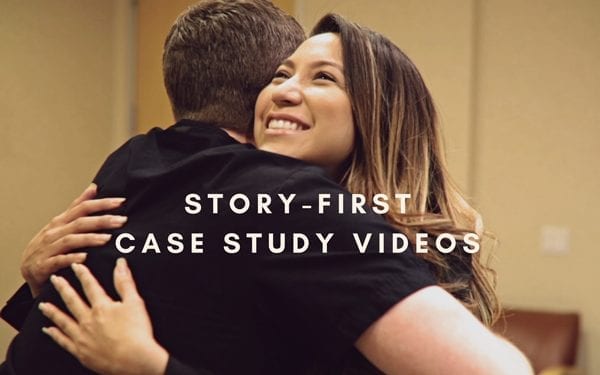Case study videos are becoming commonplace on websites that sell products and services of all kinds, and the reason is simple: We’re much more likely to buy into the efficacy of something if someone real, and someone we trust, has recommended it. In fact, according to a to Neilson’s Trust in Advertising report, 84% of people say they trust recommendations from their peers.[1]
There are many ways to go about creating a case study video, but we believe that creating a story-first case study video is the best way to emulate the word-of-mouth experience for prospective clients or customers.
What is a Story-first Case Study Video?
Story-first case study videos let happy clients talk directly to prospective clients while weaving facts and figures in at relevant times so they don’t come off as dry. Making sure that your case study video tells a story is the most effective way to ensure your case study video speaks authentically to your target audience from their perspective. You can see an example of a story-first case study that we created for our client, Dr. Barrett Plastic Surgery:
Our Method
Our story-first case study video method consists of three simple steps. To begin, think of your case study video as a mini-movie with a classic three-act structure:
Act 1: Setup
This is the fundamental aspect of making sure your message connects. Your central character should represent your target audience and should reflect their needs and wants. Their problems should mirror the most common problems of your target audience. Making the right choice here will help to create a resonant relationship between your target audience and your message. It’s important for your main character to be authentic, genuine and most importantly, comfortable on camera, so as not to disrupt the flow of information being communicated.
This section should make up about 15% of your video.
Act 2: Presentation of Problem
This section is where we strengthen the connection between the central character and the target audience, and their similar needs for the products or services your business provides. Your target audience should be able to relate to the central character’s problem, and hope for a good outcome fot eh charactedr, and by extension, themeslves. In our example, what Shekinah needs is a natural-looking lip augmentation carried out by a professional doctor with a reassuring bedside manner, which is a common request among Dr. Barrett’s target audience.
This section is the meat of the video, and should make up about 60% of the content.
Act 3: Resolution
The unique and effective solution you offer to the problem established in the first act is the star of this section. This is where your target audience gets to see the results you can deliver. In our example, we see Dr. Barrett in his element: the efficacy of his treatment, his excellent bedside manner, and a patient thrilled with the fantastic and natural-looking results he achieves.
This final section should complete the final 25% of your story-first case study video.
Summary
Dynamic video case studies that utilize the story-first are one of the best ways to communicate the value of your products or services in the most authentic and resonant ways possible. Get in touch with Ezra Productions so we can create genuine, informative, result-focused, and story-first case study videos that really engage and convert your target audience into customers and clients.

